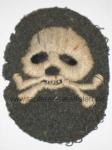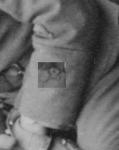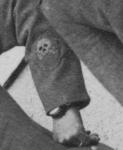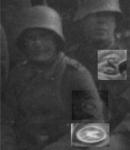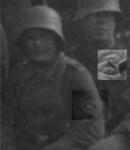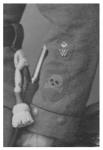
Thomas W
For Deletion-
Posts
788 -
Joined
-
Last visited
-
Days Won
3
Content Type
Profiles
Forums
Blogs
Gallery
Events
Store
Everything posted by Thomas W
-
The link says that since the Totenkopf was already drawn on a signboard in an early photo of a "Flammen-Kommando," we can assume that the choice of the badge was surely made by the troops, if not by Reddemann personally, and later officially sanctioned by the Kaiser. Details of the circumstances of the introduction or preparation of the badge cannot not be found. That contradicts what I've read, that the Totenkopf was the personal symbol of the Crown Prince, who served in the Death's Head Hussars. The letter to the flamethrower regiment written by the Crown Prince announcing the Totenkopf badge says that he himself recommended it. It's too bad that the photo of the early "Flammen-Kommando" is too small to make out any details, such as the date or the shape of the skull. This new skull is woven from bullion. It could either be an officer's version or a postwar badge worn by former members of the flamethrower regiment, who were offically allowed to wear the badge only for the duration of the war.
-
The official patterns of flamethrower Totenkopf had no such thread along the outline of the jaw. Maybe if this was a completely home-made skull, that could be right. But it makes more sense to me that if there are two undoubtably metal Totenkopf worn by flamethrower pioneers, as I've shown in my photos, this weird-looking badge with what appears to be a raised edge of the jawline would be metal rather than a cloth version with a jawline made of thread.
-
Sure, but the raised relief detail of the upper jaw isn't found on cloth badges, unless the skull and cross bones are made of separate pieces of cloth. I see the same sort of raised relief detail that I've marked in red on this SS Totenkopf, which leads me to believe that the badge in my photo is metal.
-
A loosely sewn-on cloth badge might cause a shadow, but it wouldn't create the raised relief of the upper jaw. That can only be the result of stamped or cast metal. I went through my entire colection and found another flamethrower pioneer wearing what has to be a metal badge, near the top edge of the cuff but not on it. There's no question that this is a metal badge, because it's three dimensional and has rounded edges. I've superimposed the other badge below it for comparison purposes.
-
There's a very pronounced shadow all the way around it, especially under the curve of the skull and under the crossed bones. If you look carefully, you can also see that the edge of the upper jaw is distinct from the crossed bones (see white arrow), as though the badge has been stamped from metal. In the cloth Totenkopf, the skull upper jaw is not distinct from the crossed bones. All is one flat piece. Finally, in this Totenkopf, there is no evidence of white teeth.
-
Okay, just to add to the weirdness and shoot down part of my own theory, I looked through my collection and found two photos that show flamethrower pioneers with cloth Totenkopf badges carefully positioned on the top edge of the cuff, just like the metal badges. So maybe metal isn't important, but I'll bet that the position of the badge, on the top edge of the cuff, signified something. My revised theory is that postion may be more important than material, and if it does signify something, it means that the pioneer in question is a specialist, probably in trench mortars or grenade launchers.
-
Depends on whether or not the metal badge and its placement had any particular significance. The only two photos I've seen of flamethrower pioneers wearing metal badges instead of cloth both show the badges in the same position at the top edge of the cuff. Maybe they were allowed to wear a metal badge until their cloth badge arrived, but it had to be in a different position. Maybe some flamethrower pioneers didn't want to wear the precious badge into combat and subsituted a metal one. The photos--though unclear--seem to indicate that the metal badges are slightly different than the cloth version. I have a Soldbuch of a flamethrower pioneer of the 6th Company, Garde-Reserve-Pionier-Regiment who joined the II. Garde-Pionier-Ersatz-Bataillon in March of 1918. This was the replacement batalion for the flamethrower regiment, where all the training was done. This Pionier was trained in the use of hand grenades, the Grenade Launcher 16, and the Lanz light trench mortar, but never in the use of flamethrowers. I didn't know that the flamethrower regiment had Lanz trench mortars. I've seen no mention of it in the history of the regiment written by the commander, or in the book Sturmtruppen und Flammenwerfer, that has all the tables of equipment of the regiment. It seems strange that a flamethrower pioneer wouldn't have been trained in the use of flamethrowers. Maybe the metal badge in that particular position meant that he was a trench-mortar and grenade-launcher specialist not trained in or allowed to use flamethrowers. Maybe he wore this badge so that an officer could tell at a glance that he wasn't qualified to use flamethrowers, and therefore he wouldn't be assigned certain missions. Joining the flamethrower replacement battalion in March of 1918 still gave him plenty of time to be trained in flamethrowers, but he never was.
-
Another variation on the flamethrower Totenkopf. This is clearly a metal version, without a cloth oval backing patch. The image on the left is the most-common standard pattern cloth Totenkopf, with cloth backing patch. The one in the center was taken after March of 1918, and the one on the right was taken in the summer of 1918, from a group photo of the flamethrower platoon of Sturmbataillon Nr. 14. Since we now have two photos of metal flamethrower badges worn in the same place on the cuff (the top edge), this would seem to me to indicate that both the material (metal) and the position have some sort of significance. So, Robin, now you can start looking for a metal flamethrower badge, which I figure will only be about 5000 times more rare than a cloth version.
-
The Machinegun Marksman badge had the brass ammunition belt going all the way around the edges, which would stand out clearly. These discussions show the limitations of scanners, which duplicate the rough surface of the postcards. In the original image, you can easily see with a magnifying loupe that it's an "S."
-
Thanks, Robin. There were far more unofficial badges than most people think. Just because they haven't appeared in books or in records before doesn't mean they didn't exist. Here's a man identified as a tanker from Tank 501. He's from the Kraftfahrtruppe. I know it's difficult to make out, but you can see that he has a light-gray shoulder strap with a red "K." He also has an "S" badge for Stosstrupp, similar to the one worn by the Saxons (inset). I've never heard that tankers wore Stosstrupp badges, but here's a photo of one. Since they were trained as shock troops by Sturmbataillon Nr. 5 (Rohr), obviously this guy felt he had the right to wear an "S" badge. I spent the last year writing a book on German assault troops of World War I, and I found tons of insignia and equipment that I never knew existed, even though I've read hundreds of books on the subject.
-
You haven't seen the identical badge on the left sleeve of the Rohr Sergeant, which I'm saving for my book. It's a crown with a single point above a thick-armed "W," mounted on a dark oval of cloth. Through manipulation of the imagery I was able to identify the "5" on the shoulder straps of the artillerymen. The machine guns assigned to field-artillery batteries were placed on the improvised trench mounts used by assault troops; I have other photos of that. The evidence adds up to this being a machine-gun squad of the Howitzer battery of Sturmbataillon Nr. 5 (Rohr). What clinched it is the fact that an unquestioned member of the battalion is wearing the same badge on the proper place below his elbow. Every Rohr sleeve badge I've seen has been slightly different. Every expert on German uniforms who's seen the sleeve badge on the artillery machine-gunner has been stumped, not only by the design but by the fact that it's worn on the upper right sleeve. It wasn't until I bought the photo of the Rohr Sergeant that I was able to identify the artilleryman's badge. There was no official design for the badge, as it was never approved by the Kaiser. We still don't know why there are two official variations of the flamethrower-pioneer Totenkopf badge, and until I made the connection, nobody had reported that Rohr's flamethrower pioneers wore their sleeve badges below the elbow. I have the only known photo of a Rohr flamethrower pioneer with a "5" on his shouder straps; prior to the publication of that photo, I had read that Rohr's flamethrower pioneers wore regular pioneer uniforms, but in reality they wore Guard Pioneer uniforms with a "5" on the straps. I'm confident I'm right, and it's not based on imagination. It's based on long study of the topic. You can reject it if you want. That's cool. But saying it's based on imagination is inaccurate. In these three photos the badges are all slightly different. Have you ever seen a photo before of a flamethrower pioneer wearing both the Totenkopf and the Rohr badge? I hadn't. Why is it not possible that Rohr artillerymen would wear the badge, too, but on a different sleeve? Why is it not possible that different parts of the battalion would have their own badges locally made, and some of them might have a darker cloth backing? I can't digitally enhance the original image for you the way I did for myself, because it's at the publisher's. But the surface of the card is very rough and cracked. You have to use all sorts of filters. But this badge is clearly silver bullion instead of white metal, because it's distorted by the wrinkles in the man's sleeve. If you follow the countours of the badge and account for the distortion caused by the wrinkles in the sleeve, you come up with the same basic design as the Rohr sleeve badge.
-
Actually, I have another photo of a Sergeant in Sturmbataillon Nr. 5 (Rohr) with the identical badge on his left inner elbow. So far I've identified four different variations of the Rohr sleeve badge. Two are field gray with white-metal "W" and crown (two different styles of crown); one is field gray with silvier bullion "W" and crown; and one is much darker, almost black, with silver bullion "W" and crown. This last style is the one worn by the artillery machine gunner and the Sergeant.The Rohr sleeve bade was never officially adopted, so there wasn't an official pattern. The shoulder straps show the artillery bursting shell and "5," and the badge matches the badge worn by a member of Sturmbataillon Nr. 5 (Rohr). No question. It could be that artillerymen were required to wear the badge in a different position than pioneers. From 1917 every artillery battery on the western front received a machine-gun detachment of two MG08. The interesting thing is that the man with the Rohr badge has light piping on his cap, probably meaning he's from a train battalion originally. It's a Rohr badge, my friend. I have no doubt about it.
-
It's not a theory. Here's a photo of a Kleiftrupp of Sturmbataillon Nr. 5 training at Beuville in September of 1916. All three wear their Totenkopf patches below the elbow. The 14 flamethrower pioneers attached to Sturmbataillon Nr. 5. who were killed in action are not mentioned in the death book of the Garde-Reserve-Pionier Regiment, which means they were not considered members of the flamethrower regiment when attached to Rohr's unit. All other flamethrower pioneers attached to assault battalions were stil considered members of the flamethrower regiment. Rohr's flamethrower pioneers also wore a "5" on their shoulder straps, even though they were issued Garde Pionier uniforms. There's no question that Rohr's men wore their Totenkopf patches below the elbow, the same position they wore the later "W" badge. That's why this guy has placed his Totenkopf badge below his "W" badge. He had no other way to wear both badges. By the way, I have a photo of a machine gunner attached to the Howitzer Battery of Sturmbataillon Nr. 5 (Rohr), and he wears his "W" badge on his upper right arm.
-
This is on eBay right now. I was getting ready to budget out an insane amount of money, because I've never seen the Garde-Reserve-Piionier-Regiment and Sturmbataillon Nr. 5 (Rohr) badges worn by the same guy. I was going to fight tooth and nail for it. To the death, I tell you! But it's a reproduction photo. Oh, well.


